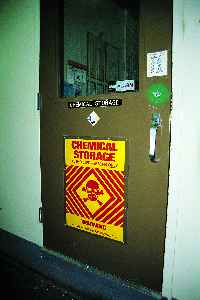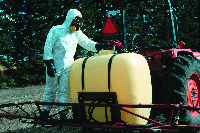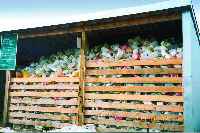| | Pesticides | Storage | Mixing and loading | Disposal
Agricultural inputs include pesticides, commercial fertilizer, manure, and petroleum products. All products should also be stored in a safe and secure manner, handled to prevent contamination of water and air, and disposed of properly according to the environmental regulations.
Protective clothing and equipment are vital for anyone handling agricultural chemicals. See ARD's Crop Protection manual (the 'blue book') for more information.
Pesticides
Pesticides used in crop production include herbicides, fungicides, insecticides, rodenticides and pesticide-treated seed. Improper storage and handling of pesticides can contaminate soil, water and air and can harm humans, animals and plants. Always follow proper procedures and precautions. Some producers choose to use custom applicators for pesticide applications.
Storage
No pesticide should be stored on the farm. Order only the amount needed and use it immediately. If you cannot use it immediately then have it stored by the supplier. Suppliers are set up to handle the product as a hazardous good. This eliminates the liability of accidents.
If you must store a pesticide on the farm, follow the guidelines below.
Product storage
- The amount stored must be less than 20 L or 20 kg of product (under the Environmental Protection and Enhancement Act). Storage time should not exceed one month.
- Consult the pesticide's label for specific storage instructions.
- Store the pesticide in the original containers with the manufacturer's labels; if supplementary containers are used, make sure they are properly labelled.
- Do not store with food, feed, seed, drinking water or protective equipment.
- If a product container is leaking, overpack the container by packing it in a larger container with leak collection material (such as kitty litter).
- As a precaution, use secondary containment made of an impermeable material to contain possible leaks. For example, store chemical jugs in tubs or trays on storage shelves.
Storage facility
- Store pesticides in a secure facility, and post signs indicating the contents of storage.
- Locate the facility more than 30 m (100 ft) from a surface water body and more than 90 m (300 ft) from a water well.
- Locate the facility downslope and downwind from any water sources.
- Ensure the facility is constructed to contain spills and minimize or eliminate the potential of contaminating soil and water.
- Install an impermeable floor (e.g. sealed concrete).
- Use curbs to contain leaks.
- Do not have a floor drain. If there is a drain, use a proper holding tank for drainage collection, monitor the tank regularly, and dispose of the fluid in the tank in accordance with hazardous waste regulations.

Store pesticides in a secure facility with posted signs.
Courtesy of ARD
Emergency plan
Prepare an emergency plan in case of a leak or spill at the storage site or when handling. This written plan should include the location of emergency equipment, emergency telephone numbers, cleanup methods and steps to follow.
Make sure the following materials for spill cleanup are readily available:
- absorbent material (such as kitty litter)
- shovel
- waste container
- protective equipment - rubber gloves, rubber boots
Mixing and Loading
When mixing and loading pesticides into the sprayer, it is inevitable that a spill will occur some day. Using proper procedures and precautionary methods will minimize or eliminate the risk of contamination.
Mixing location
- Any mixing and loading areas must be more than 30 m (100 ft) from a surface water body and more than 90 m (300 ft) from a water well.
- The best option is to mix and load pesticides in the field near the application site. For this option:
- Change the location of the mixing and loading site with each application.
- Bring the water to the site in a nurse tank.
- If you are mixing at a permanent site:
- Make sure the mixing and loading area can contain spills and drips. It should be able to contain 125% of the sprayer's tank volume. Install an impermeable floor and curbs to contain product. Install a sump to collect product.
- Cover the mixing pad to eliminate increased volumes of contaminated water from run-on water and precipitation, or design the area to contain these larger volumes.

Using proper procedures and protective clothing will minimize or eliminate potential risk of contamination.
Courtesy of ARD
Loading
- Do not leave filling equipment unattended. Have someone in control of the filling operation for the entire time.
- Have spill containment and cleanup equipment on hand. Have a phone available for emergency calls.
- To prevent backflow from the sprayer to the water source:
- Fill the sprayer from a nurse tank away from wells or other bodies of water.
- Never place a hose into the sprayer below the water line. Leave a minimum 6-inch (15-cm) gap between the hose and the water.
- Install backflow preventer devices on all water pipes leading to the storage area and the pad.
- Spray equipment must be fitted with an effective backflow preventer to be permitted to take public surface water (refer to the Environmental Protection and Enhancement Act).
Cleaning field equipment
- Wash the spraying equipment at different locations to prevent chemical buildup in the field.
- When changing pesticide products, clean out the tanks with water to ensure no product contamination occurs.
- If possible, rinse the tank in the field, and apply the rinse water (called rinsate) directly to crop. If you cannot apply it to the crop, then:
- apply it on land away from surface water, water wells, septic systems, gardens, shelterbelts and other environmentally sensitive areas, or
- use it as mix water for later applications when the same chemical is being applied, or
- apply it on areas requiring total vegetation control (e.g. chemfallow).
Pesticide Transportation
Pesticides should be secured during transportation. They should not be transported with food, feed, household furnishings, toiletries, clothes, bedding or similar items.
Disposal
Pesticide disposal
Pesticides are hazardous wastes and cannot be disposed of in sanitary landfills or by burning. To dispose of pesticides:
- Return unopened and leftover product to the dealer for a refund.
- If you are unable to use opened pesticide supplies, offer them to neighbours.
- Pesticides that have no further use must be disposed of as hazardous waste. The names of companies licensed to handle hazardous waste can be obtained from Alberta Environment's Recycle Information Line at 1-800-463-6326.
Pesticide container disposal
Empty pesticide containers must be disposed of carefully. Unrinsed empty pesticide containers have the potential to contaminate groundwater and surface water, and can be toxic to fish and wildlife.

Empty pesticide containers must be disposed of at a pesticide container disposal site.
Courtesy of Alberta Environment
Under Alberta's Environmental Protection and Enhancement Act, non-refillable plastic or metal pesticide containers (restricted agricultural and industrial products) must be disposed of at a pesticide container collection site. A list of pesticide container disposal sites and their hours is available from each municipality, in Crop Protection (ARD) or from Alberta Environment.
Pesticide containers must be triple rinsed or pressure rinsed and dry before they are delivered to the pesticide container site. For details on rinsing, consult Crop Protection (ARD).
Paper and cardboard outer wrappings that have not been contaminated with pesticides can be recycled at a recycling centre. Any cardboard that has been contaminated due to a container rupture, accidental spill, or improper handling procedure, should be taken to a sanitary landfill. Evidence of cardboard contamination includes signs of exposure to liquid, powder or granules, or a strong chemical odour. Some pesticide container sites have bins or separate areas for collecting outer packaging materials. Do not burn paper bags or cardboard containers. Containers should not be reused, and empty containers should be made unsuitable for reuse.
- For more information on pesticide storage, handling and disposal, see Crop Protection (ARD). For specific information on the disposal of product or cleanup of spills, contact Alberta Environment's Environmental Response Centre at 1-800-222-6514.
Back to Chapter 4 - Storage, Handling and Disposal of Agricultural Inputs |
|